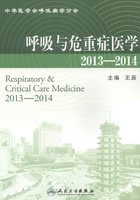
上QQ阅读APP看书,第一时间看更新
12 病毒感染致慢性阻塞性肺疾病急性加重的“前因与后果”
王蕾 杨岚
慢性阻塞性肺疾病(COPD,简称慢阻肺)是一组严重危害人们健康的慢性进行性疾病。根据国内近年统计资料,我国共约有4000万慢阻肺患者,其死亡率在我国农村和北方地区占第一位;据世界卫生组织估计,到2020年全球该组疾病的死亡率将升到第三位 [1]。由于其患病人数多、死亡率高、社会经济负担重,已经成为一个重要的社会公共问题。此外,慢阻肺急性加重(AECOPD)是导致医疗费用增加、患者生活质量下降及肺功能下降的重要原因 [2]。目前AECOPD的发病机制尚未完全阐明,通常认为感染是导致AECOPD发生的独立的最重要的因素,占引起AECOPD发生所有因素的50% [3],其中最常见的病原体为细菌、病毒、非典型病原体,病毒占所有感染病原体的40%~60% [4-6],在流感季节慢阻肺患者的住院率明显升高 [7]。病毒较难分离、检测,且治疗效果不佳,故病毒感染在AECOPD中的研究较少,国内的相关研究更少,而病毒感染与慢阻肺急性加重密切相关,故此文将就两者的因果关系进行阐述。
一、AECOPD患者中病毒感染的流行情况
近年来,越来越多的研究表明呼吸道病毒感染与AECOPD发生密切相关 [8],近几年发展的PCR、RT-PCR及芯片技术大大提高了病毒检测能力,使临床医师逐渐意识到AECOPD患者中病毒感染并不少见 [9],故AECOPD病毒感染的流行病学研究对于临床医师更好地认识AECOPD及制订有效的治疗方案极为重要。不同文献报道病毒感染阳性率差别较大,2014年有学者对既往17项研究的1934例慢阻肺患者的病原学进行分析,得出AECOPD患者中病毒感染的总体患病率为39.3%,稳定期患者为13.6% [10],其中有文献报道的最高的病毒感染率为56% [11],最常见的病毒依次为鼻病毒(17.3%) [12]、流感病毒(7.1%)、呼吸道合胞病毒(5.3%)、冠状病毒(3.1%)、副流感病毒(2.6%)、腺病毒1.1%)及偏肺病毒(0.7%)等。另有文献报道慢阻肺患者可能存在EB病毒的持续感染 [13]。AECOPD患者中病毒流行存在地域差异,欧洲发病率最高,然后依次为美洲、澳洲及亚洲 [14]。
在ICU,需要机械通气的AECOPD患者中病毒感染亦是加重疾病负担的重要因素。有一项研究表明 [15],需要机械通气的AECOPD患者中,43%的患者病原体可能为病毒,33%的患者病毒为其唯一的病原体,10%的患者合并病毒感染,而78%的病毒感染发生在冬春季。
当然病毒和细菌可合并感染,首先,病毒感染后可改变呼吸道上皮细胞受体表达,从而使细菌黏附、侵入增加;再者,细菌感染后可使病毒的易感性增加。有一项研究表明,在AECOPD患者入院时合并感染率为9%,住院第5天时合并感染率可升至13.6% [16],且约71%存在细菌感染的AECOPD患者在起病时可有病毒感染的相关症状,另一项研究报道,约27%的AECOPD患者存在细菌和病毒的混合感染 [17]。由此可见,病毒及细菌的混合感染应引起临床医师的高度重视。
二、“前因”——病毒感染在AECOPD发生中的机制
病毒感染在慢阻肺中并不少见,且是导致慢阻肺急性加重的重要因素。那么其在AECOPD发生中的作用又是如何,近年来也有较多学者致力于这方面的研究。接下来将对病毒感染在AECOPD发病机制中的作用做简要阐述。
首先,病毒可活化炎性细胞,促进炎症因子的产生和释放。呼吸道病毒感染后,可招募并活化炎性细胞,致炎性细胞侵入气道。AECOPD患者存在局部及全身炎症反应,各炎性介质水平升高,如IL-6、IL-8、IFN-γ、MCP-1、TNF-α及CRP等,而病毒感染可进一步促进各炎症介质的产生与释放 [18-20],从而加重气道及全身炎症反应,致炎症介导的组织损伤。
其次,病毒感染可加剧气道阻塞,病毒感染的慢阻肺患者的FEV 1、FEV 1%、FEV 1/FVC%明显下降 [21]。病毒感染可使气道上皮细胞受损,而气道上皮可产生上皮细胞舒张因子,病毒感染后造成气道上皮坏死,各种上皮细胞舒张因子产生及释放减少,造成气道狭窄;另外,病毒感染可致气道炎症、肺泡壁结缔组织增生、呼吸道平滑肌收缩和增生及黏膜水肿等,以上各因素均可致气道狭窄。
最后,病毒感染参与AECOPD的免疫反应。气道上皮细胞作为病毒感染的起始部位,可启动机体的固有免疫,其释放的细胞因子及趋化因子可活化免疫细胞,并产生防御素——HBD-2、HBD-3 [22]。防御素可趋化多种免疫细胞,在连接固有免疫和特殊免疫中起重要作用 [23]。一旦感染病毒,可有病毒颗粒释放到气道,这些病毒颗粒与单核细胞、巨噬细胞及树突细胞反应,释放多种细胞因子及趋化因子而形成炎性环境,加重气道及全身炎症反应。另外,病毒感染可促进B细胞分泌IgE和IgG4,两者在喘息发病中起重要作用 [24]。
三、“后果”——病毒感染对慢阻肺患者的影响
存在病毒感染的AECOPD患者可表现为上呼吸道感染症状(喷嚏、鼻塞、流涕、咽痛、流泪、味觉减退、呼吸不畅、声嘶等)、发热、寒战、肌痛 [11,16],有时发热为唯一的临床表现,其中流涕(82%)和咽痛(59%)为最常见的症状,常与鼻病毒感染相关 [25]。
病毒感染所致的AECOPD通常病情更重,增加其发作次数和住院率 [26],患者的FEV 1、FEV 1%、FEV 1/FVC%及弥散功能均明显下降,常伴显著的低氧血症,有文献表明,几乎所有存在偏肺病毒感染的AECOPD患者的氧饱和度均有不同程度的下降,平均为88.2% [27],另外,病毒感染为发生心脑血管疾病的独立危险因素 [28],故其住院时间明显延长,症状缓解时间约为非病毒感染患者的2倍 [29]。一般认为细菌和病毒同时感染的AECOPD患者临床症状更重、炎症标志物水平更高,但有文献称,与单一病原体感染相比,病毒及细菌混合感染并不加重患者的临床症状及影响疾病复发 [17]。
四、AECOPD治疗中的抗病毒治疗
(一)戒烟
吸烟本身就是慢阻肺发病的重要病因 [30],研究表明吸烟可进一步加重病毒感染所致的局部及全身炎症反应 [31-33],故戒烟是治疗的前提。
(二)疫苗接种
接种疫苗仍是预防病毒感染的有效手段,如H1N1流感疫苗。在冬春季节可对慢阻肺患者进行相关病毒疫苗的接种,以降低病毒感染风险。
(三)抗病毒药物
早有研究表明单纯应用抗生素对于治疗AECOPD的效果有限 [34,35],进一步说明了病毒感染在AECOPD中的高发病率,对于这部分患者的治疗,需尽早应用抗病毒药物,如利巴韦林及抗流感病毒药物奥司他韦、扎那米韦等,可明显改善患者的预后及减少医疗费用。结合我国为发展中国家,神经氨酸酶抑制剂仅占医疗总费用的0.11%,且价格较昂贵,可考虑应用中成药抗病毒治疗 [36],如莲花清瘟颗粒、金花清感颗粒、抗病毒颗粒等。
(四)糖皮质激素
全身激素应用为AECOPD的常规治疗,认为其可改善AECOPD患者的局部及全身炎症反应,而有研究在动物水平证实全身应用激素并不能改善流感病毒感染诱导的炎症反应,反而加重患者的临床症状 [37],对于存在流感病毒感染的AECOPD患者,该研究不推荐全身应用激素。故是否使用糖皮质激素仍存在争议,需要更多的基础及临床研究去解决该问题。
(五)抗炎治疗
既然AECOPD患者存在局部及全身炎症反应,各项炎性介质不同程度升高,且病毒感染可加重这一过程,那么抗炎(anti-inflammatory)治疗则占重要地位。近年来,有研究表明治疗2型糖尿病的PPAR-γ激活剂吡格列酮可明显减轻流感病毒所致的炎性反应 [38,39]。另外,其他抗炎分子(如TNF-α、IL-8拮抗剂、抗蛋白酶药物、促炎激酶抑制剂等)在AECOPD治疗作用中的研究也是近年来的研究热点。
由此可知,病毒感染是慢阻肺急性加重的重要诱发因素,应引起临床医师的重视。加强对病毒感染与AECOPD的相关性研究,可明确病毒感染在AECOPD发生中的作用机制,并为AECOPD的治疗,尤其是抗病毒治疗提供理论依据。
参考文献
1.Barnes PJ.Therapy of chronic obstructive pulmonary disease.Pharmacol Ther,2003,97:87-94.
2.Donaldson GC,Seemungal TA,Bhowmik A,et al.Relationship between exacerbation frequency and lung function decline in chronic obstructive pulmonary disease.Thorax,2002,57:847-852.
3.Connors AF,Dawson NV,Thomas C,et al.Outcomes following acute exacerbation of severe chronic obstructive lung disease.The SUPPORT investigators(Study to Understand Prognoses and Preferences for Outcomes and Risks of Treatments).Am J Respir Crit Care Med,1996,154:959-967.
4.Mallia P,Johnston SL.Mechanisms and experimental models of chronic obstructive pulmonary disease exacerbations.Proc Am Thorac Soc,2005,2:361-366;discussion 71-72.
5.Vlahos R,Bozinovski S,Gualano RC,et al.Modelling COPD in mice.Pulm Pharmacol Ther,2006,19:12-17.
6.Wright JL,Churg A.Animal models of cigarette smoke-induced COPD.Chest,2002,122:301S-306S.
7.Wesseling G.Occasional review:influenza in COPD:pathogenesis,prevention,and treatment.Int J Chron Obstruct Pulmon Dis,2007,2:5-10.
8.Mohan A,Chandra S,Agarwal D,et al.Prevalence of viral infection detected by PCR and RT-PCR in patients with acute exacerbation of COPD:a systematic review.Respirology,2010,15:536-542.
9.Sethi S.Molecular diagnosis of respiratory tract infection in acute exacerbations of chronic obstructive pulmonary disease.Clin Infect Dis,2011,52(Suppl 4):S290-295.
10.Wu X,Chen D,Gu X,et al.Prevalence and risk of viral infection in patients with acute exacerbation of chronic obstructive pulmonary disease:a meta-analysis.Mol Biol Rep,2014.
11.Rohde G,Wiethege A,Borg I,et al.Respiratory viruses in exacerbations of chronic obstructive pulmonary disease requiring hospitalisation:a case-control study.Thorax,2003,58:37-42.
12.Mallia P,Message SD,Kebadze T,et al.An experimental model of rhinovirus induced chronic obstructive pulmonary disease exacerbations:a pilot study.Respir Res,2006,7:116.
13.McManus TE,Marley AM,Baxter N,et al.High levels of Epstein-Barr virus in COPD.Eur Respir J,2008,31:1221-1226.
14.Beckham JD,Cadena A,Lin J,et al.Respiratory viral infections in patients with chronic,obstructive pulmonary disease.J Infect,2005,50:322-330.
15.Cameron RJ,de Wit D,Welsh TN,et al.Virus infection in exacerbations of chronic obstructive pulmonary disease requiring ventilation.Intensive Care Med,2006,32:1022-1029.
16.Hutchinson AF,Ghimire AK,Thompson MA,et al.A communitybased,time-matched,case-control study of respiratory viruses and exacerbations of COPD.Respir Med,2007,101:2472-2481.
17.Perotin JM,Dury S,Renois F,et al.Detection of multiple viral and bacterial infections in acute exacerbation of chronic obstructive pulmonary disease:a pilot prospective study.J Med Virol,2013,85:866-873.
18.Rohde G,Borg I,Wiethege A,et al.Inflammatory response in acute viral exacerbations of COPD.Infection,2008,36:427-433.
19.Almansa R,Socias L,Andaluz-Ojeda D,et al.Viral infection is associated with an increased proinflammatory response in chronic obstructive pulmonary disease.Viral Immunol,2012,25:249-253.
20.Zhang Y,Luxon BA,Casola A,et al.Expression of respiratory syncytial virus-induced chemokine gene networks in lower airway epithelial cells revealed by cDNA microarrays.J Virol,2001,75:9044-9058.
21.Matsuse T,Hayashi S,Kuwano K,et al.Latent adenoviral infection in the pathogenesis of chronic airways obstruction.Am Rev Respir Dis,1992,146:177-184.
22.Proud D,Sanders SP,Wiehler S.Human rhinovirus infection induces airway epithelial cell production of human beta-defensin 2 both in vitro and in vivo.J Immunol,2004,172:4637-4645.
23.Proud D.The role of defensins in virus-induced asthma.Curr Allergy Asthma Rep,2006,6:81-85.
24.Proud D,Chow CW.Role of viral infections in asthma and chronic obstructive pulmonary disease.Am J Respir Cell Mol Biol,2006,35:513-518.
25.Hutchinson AF,Black J,Thompson MA,et al.Identifying viral infections in vaccinated Chronic Obstructive Pulmonary Disease(COPD)patients using clinical features and inflammatory markers.Influenza Other Respir Viruses,2010,4:33-39.
26.Wark PA,Tooze M,Powell H,et al.Viral and bacterial infection in acute asthma and chronic obstructive pulmonary disease increases the risk of readmission.Respirology,2013,18:996-1002.
27.Hamelin ME,Cote S,Laforge J,et al.Human metapneumovirus infection in adults with community-acquired pneumonia and exacerbation of chronic obstructive pulmonary disease.Clin Infect Dis,2005,41:498-502.
28.Nichol KL,Nordin J,Mullooly J,et al.Influenza vaccination and reduction in hospitalizations for cardiac disease and stroke among the elderly.N Engl J Med,2003,348:1322-1332.
29.Seemungal T,Harper-Owen R,Bhowmik A,et al.Respiratory viruses,symptoms,and inflammatory markers in acute exacerbations and stable chronic obstructive pulmonary disease.Am J Respir Crit Care Med,2001,164:1618-1623.
30.Mannino DM,Buist AS.Global burden of COPD:risk factors,prevalence,and future trends.Lancet,2007,370:765-773.
31.Robbins CS,Bauer CM,Vujicic N,et al.Cigarette smoke impacts immune inflammatory responses to influenza in mice.Am J Respir Crit Care Med,2006,174:1342-1351.
32.Gualano RC,Hansen MJ,Vlahos R,et al.Cigarette smoke worsens lung inflammation and impairs resolution of influenza infection in mice.Respir Res,2008,9:53.
33.Kang MJ,Lee CG,Lee JY,et al.Cigarette smoke selectively enhances viral PAMP- and virus-induced pulmonary innate immune and remodeling responses in mice.J Clin Invest,2008,118:2771-2784.
34.Rothberg MB,Pekow PS,Lahti M,et al.Antibiotic therapy and treatment failure in patients hospitalized for acute exacerbations of chronic obstructive pulmonary disease.JAMA,2010,303:2035-2042.
35.Llor C,Moragas A,Hernandez S,et al.Efficacy of antibiotic therapy for acute exacerbations of mild to moderate chronic obstructive pulmonary disease.Am J Respir Crit Care Med,2012,186:716-723.
36.Zhong NS,Li YM,Yang ZF,et al.Chinese guidelines for diagnosis and treatment of influenza(2011).J Thorac Dis,2011,3:274-289.
37.Bauer CM,Zavitz CC,Botelho FM,et al.Treating viral exacerbations of chronic obstructive pulmonary disease:insights from a mouse model of cigarette smoke and H1N1 influenza infection.PLoS One,2010,5:e13251.
38.Aldridge JR,Moseley CE,Boltz DA,et al.TNF/iNOS-producing dendritic cells are the necessary evil of lethal influenza virus infection.Proc Natl Acad Sci U S A,2009,106:5306-5311.
39.Birrell MA,Patel HJ,McCluskie K,et al.PPAR-gamma agonists as therapy for diseases involving airway neutrophilia.Eur Respir J,2004,24:18-23.